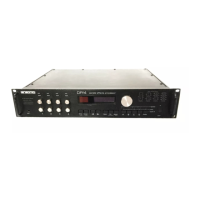Section 2 — Algorithms
78 ENSONIQ DP/4+ Reference Manual
REVERSEREVERB1
ReverseReverb1 produces a reverberation that gradually increases, simulating a backwards
sound with a maximum duration of several seconds. When a signal enters this algorithm, the
plate reverb (from which this algorithm is derived) is almost instantaneously turned on, and then
the output volume is ramped up. This algorithm will only trigger one time. ReverseReverb1 is
triggered by an input signal level (threshold) determined by the user. Once triggered, the reverse
envelope will proceed to completion, and ignore subsequent trigger levels. If you are looking for
a reverse effect that will retrigger, try using Reverse Reverb 2. The topology of the Reverse
Reverb is similar to the Plate Reverb.
01 — Mix
02 — Volume
See the descriptions under the Mix and Volume Parameters, found earlier in this section.
RELEASE
TIME
ATTACK TIME
HOLD TIME
LEVEL
TIME
03 — Envelope Hold Time Range: 1ms to 10.0s
Controls the amount of time that the reverse will sound after it has been triggered. Rule of
thumb: Don’t set the hold time much longer than the attack time (see diagram above).
04 — Envelope Attack Range: 1ms to 10.0s
Sets the duration over which the reverb builds. It is recommended that you set this value less
than the hold time (parameter 03).
05 — Envelope Release Range: 1ms to 10.0s
Determines the release time after the hold time has elapsed. Generally this time is very short.
Lower values offer an abrupt cutoff.

